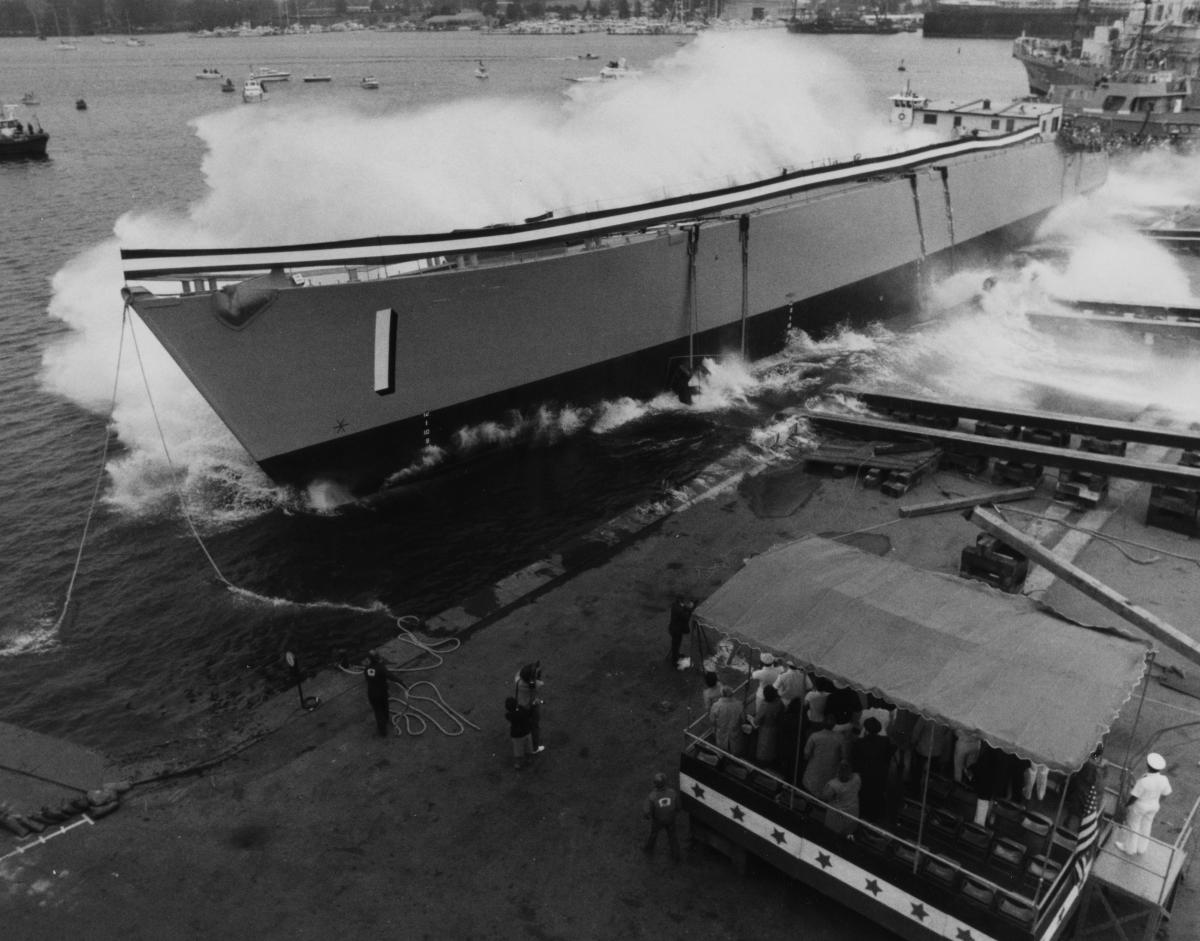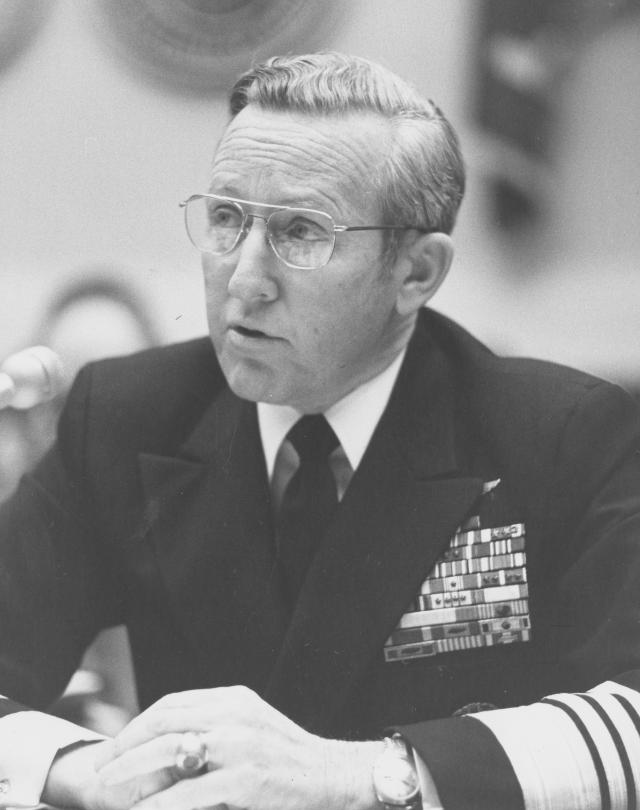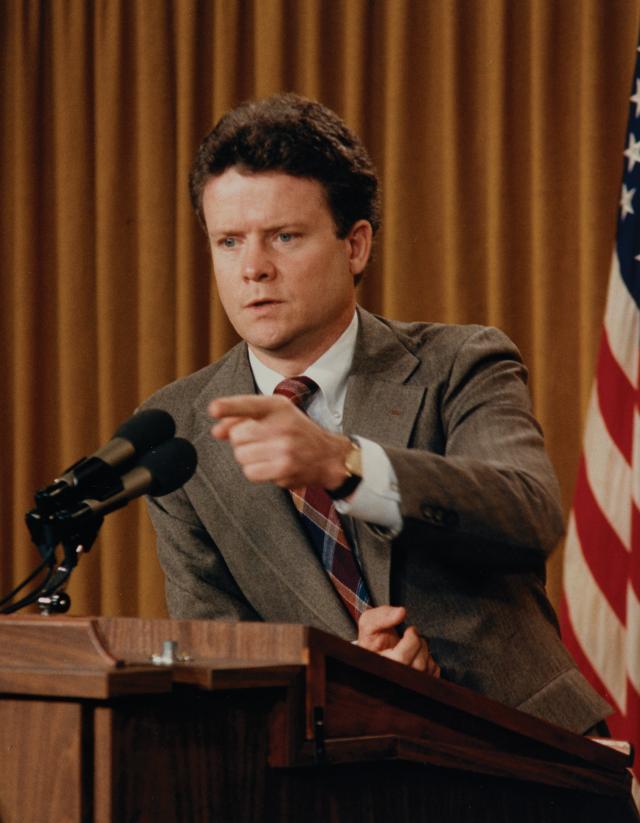The U.S. Navy of the 1980s provides a reminder what serious peer competition in the naval sphere looks like and the resources and human willpower that it requires. E. B. Potter describes the 1980s buildup to counter the Soviet Union as the “most expensive peacetime military buildup in the nation’s history, to cost $1.5 trillion in five years . . . the Navy would be built up from 456 to 600 ships, including 15 carrier-centered battle groups.”1
The 1980s maritime strategy and naval buildup was advocated by senior officers in uniform, approved by civilian leadership, and then laboriously implemented across all levels. Growing pains were worked out, and complex exercises in frigid environments executed. The renaissance of naval strategic thought in the late 1970s and subsequent buildup of the 1980s should provide a source of strength and inspiration to today’s sailors and civilian defense officials. Lessons in strategy, fleet exercises, and force structure remain directly relevant.
In 1978, the Navy faced a bleak outlook. Following a decades-long insurgency in Vietnam, the U.S. Navy was being outpaced by Soviet Navy by most metrics. Although the United States maintained a 21-to-3 aircraft carrier advantage, the Soviets outnumbered the United States in surface warships 443 to 196 and in submarines 294 to 119.2 Ambiguity permeated discussions of how naval strategy fit with national strategy; one historian asserts that during the late ’70s, “there was very little agreement within the government over the Navy’s principal missions and how to structure the fleet to meet them.”3
A clearly defined naval strategy with concrete operations and tactics guided the 1980s naval expansion. John Lehman, Secretary of the Navy from 1981 to 1987, notes that President Ronald Reagan “approved the Navy recommendation to begin at once pursuing a forward strategy of aggressive exercising around the vulnerable coasts of Russia,” and “this demonstrated to the Soviets that we could defeat the combined Warsaw Pact Navies and use the seas to strike and destroy their vital strategic assets with carrier-based air power.”4 Active-duty naval officers such as Admiral James Holloway, Admiral Thomas Hayward, and Admiral James Lyons had long been advocating for such a strategy. These officers, as well as many others, rejected the consensus view of the previous Carter administration on the role of the Navy in a war with the Soviet Union:
Carter subscribed to the NATO strategy that called for employing most of America’s military resources to support the Allied front in Germany. The Navy’s primary role would be defense of the Atlantic SLOC [sea lines of communication], a task that would not require many large deck carriers. Carter’s SLOC strategy prompted Admiral Holloway and a number of naval analysts to warn that if the Navy implemented this policy, it would be unable to perform other vital wartime tasks . . . the strategy essentially ceded the Pacific theater to the Soviets.5
As Chief of Naval Operations (CNO), Admiral Holloway initiated a rigorous study at the Naval War College in 1977. The conclusion of this “deductive strategy” called Sea Plan 2000 proposed “a more aggressive approach to the use of naval forces in the Cold War and included a force structure considerably larger than what was then in the administration plan.6 Sea Plan 2000 laid the intellectual groundwork for the 1980s naval buildup. Admiral Hayward arrived at a similar conclusion commanding the 7th Fleet and then the entire Pacific fleet in the late 1970s, both of which he readied for a global maritime strategy. He prepared the fleets for an immediate offensive strategy against the Soviet Far East despite the Carter administration’s view that these forces should swing to Europe.7
Later, as CNO, Hayward argued forcefully for a Navy that could command the seas globally. In a 1978 U.S. Naval Institute Proceedings article, he asserted, “As long as we possess a clear margin of maritime superiority, the incentive to challenge our capability will be greatly diminished.”8 Finally, Admiral Lyons developed many of the operational concepts required of this forward offensive strategy and led the first three major exercises in the High North as Secretary Lehman’s handpicked 2nd Fleet commander. Lehman described him as “one of the principal architects of the Northern Strategy” and “anxious to get into the icy bastions that the Soviet Sailors considered their domain.”9 Thus, active-duty naval officers rejected the consensus strategy of the 1970s and laid the groundwork for the global maritime strategy of the 1980s, emphasizing enduring tenets of sea power.
Required: Robust Naval Exercises and Training
Lehman describes how the Navy visibly drilled around clearly defined operations and tactics that flowed from the 1980s global maritime strategy:
Nine months after the President’s inauguration, three U.S. and two Royal Navy carriers executed offensive exercises in the Norwegian Sea and Baltic. In this and subsequent massive exercises there and in the northwest Pacific carried out every year, carrier aircraft proved that they could operate effectively in ice and fog, penetrate the best defenses, and strike all of the bases and nodes of the Soviet strategic nuclear fleet.10
(U.S. Naval Institute Photo Archive)
Three carriers, operating and working together in concert, were a routine evolution that the 1980s force structure enabled and competition with the Soviet Union demanded. Integrated dual-carrier strike group operations are not something learned overnight; they naturally require more complexity at all levels, from the officer of the deck on the bridge of the escorts to planning and executing cyclic flight schedules. Executing fleet exercises of this magnitude are tremendous undertakings that will not occur without laborious planning and fortitude in execution.
In a 1986 defense of the maritime strategy in Proceedings, Lehman described the scale of the naval exercises of the 1980s and how strategy guided this training:
Title 10 of the U. S. Code charges the Secretary of the Navy with ensuring the highest level of training appropriate to the responsibilities placed upon both the Marine Corps and the Navy. That is what strategy provides to us—a framework within which to train. For example, U. S. naval forces recently conducted a major training exercise, “Ocean Safari 85,” with our NATO allies and the U.S. Coast Guard and Air Force. The “Safari” assembled off the East Coast of the United States and fought its way across the Atlantic, moved north of England and east of Iceland, and ended up in the Norwegian Sea. Approximately 155 ships and 280 fixed-wing aircraft and helicopters operated for four weeks in this environment, against 19 real Soviet ships and submarines and 96 Soviet aircraft sorties.11
Taking “great-power competition” as more than just a buzzword requires robust naval exercises so that the Navy can practice like it would fight when confronting a peer adversary. Exercises of such magnitude require depth in the force structure.
Penetrating deep into areas where Soviets had significant assets required electronic deception and emissions control. Admiral Lyons explained how central these concepts were to his fleet exercises in the Norwegian Sea and High North:
The first thing I did after taking command was to tear up the old canned Ocean Venture OPORD [operation order] . . . They were still using World War II carrier formations . . . such a formation was easily tracked by Soviet satellites. What we did was plot out Soviet satellite area footprints and time of exposure. We then went to dispersed dispositions. We used a number of cover and deception decoys and tactics.12
Lehman describes one exercise where Lyons endeavored to make “his entire strike group disappear” through emissions control and foul weather, then reappearing in the Norwegian Sea to the Soviets’ surprise.13 Utilizing military deception and emissions control effectively is a skill that requires practice and risk management but is necessary when operating within a peer adversary’s weapon’s release range.14
Moreover, the geography of this competition demanded that the Navy operate in difficult environments to strike Soviet vulnerabilities. One carrier commanding officer stated his focus was “keeping my aviators alive,” given the unforgiving environment where visibility and ceiling suddenly would drop to zero.15 Geography has not changed, and the peripheries of both Russia and China remain difficult environments. The Navy needs to stay the course in re-habituating to these challenging areas.16
The naval strategy of the 1980s, advocated by naval officers and then painstakingly implemented in the unforgiving High North and Pacific by American sailors, had a major effect in turning the tide of the Cold War. Showing concrete resolve in the naval sphere provided a physical reminder of U.S. strength, cemented alliances, and had a major effect in breaking the Soviets’ will. As Lehman notes, “Subsequent testimony from members of the Soviet General Staff attested that this was a major factor in the deliberations and the loss of confidence in the Soviet government that led to its collapse.”17
Force-Structure Lessons of the 600-Ship Navy
The 600-Ship Navy occurred without hollowing the force or falling behind in technological advancements. The 1980s buildup centered on proven platforms while at the same time making critical investments in precision-guided munitions, electronic warfare, and standoff jamming.18 Admiral Hayward made very clear that naval expansion must be made without a decline in readiness:
. . . units which are incapable of meeting the threat are, in a sense, worse than none, because they give some a false sense of our total capabilities vis-à-vis the Soviets. This means that quality cannot generally be traded off for quantity. At the same time, quantity does matter and there is clearly an absolute minimum in numbers of combatant units below which we cannot safely go.19
(U.S. Naval Institute Photo Archive)
Hayward further noted that the 1978 force levels were the minimum: “Our present forces, and the sailors who man them, are severely stressed to meet peacetime commitments. They would be very heavily taxed to discharge their global responsibilities in war.”20
Some defense planners today advocate wagering the future on unmanned systems, artificial intelligence, and cyber at the expense of traditional platforms to counter China.21 While these disruptive technologies undeniably require investment, using them to justify broad cuts in traditional platforms at a time when the Navy needs to grow would take on a dangerous level of risk. Indeed, the Ford, Zumwalt, and littoral combat ship highlight the pitfalls of betting that new technology can revolutionize naval warfare and offset a reduction in hulls. Senators Jack Reed (D-RI) and Jim Inhofe (R-OK) recently called for a more prudent approach to force structure, imploring “the return to an Aegis-type development model in which critical subsystems are matured before the Navy procures the lead ship of a new class.”22 Admiral Holloway wrote an entire Naval Warfare Publication to assist force-structure planning and emphasized the centrality of risk assessment:
Naval force structure is derived from consideration of strategy, threat, and risk. If proper strategy is projected, the threat correctly assessed, and risks accurately identified, uncertainty can be minimized and naval requirements can be established.23
A realistic sense of risk should be at the forefront when eliminating proven platforms for untested technology. At present, China certainly is not relying solely on disruptive technologies to take command of the seas. With 360 ships and a Navy rapidly growing faster than other nation, the pace of conventional Chinese naval expansion is staggering.24
Admiral Hayward explicitly rejected the notion that offsetting technology superseded the maintenance of the 12 carrier battle groups:
The fiscal margin for development and deployment of radically new platforms and systems will be small indeed, severely limiting our ability to innovate in major ways. This means we must carefully select those initiatives which appear to offer significant payoff . . . and pursue them in a deliberate and carefully structured way so as to maximize the potential technological payoff from our investment.25
While unmanned systems require integration and development, leaders should reject any delusions that these untested technologies will be the panacea for the simply difficult undertaking of growing, maintaining, and training a fleet to deter China and Russia.
While defeating the Soviet Union guided the building of the 600-Ship Navy, other hot spots competed for resources. In the 1980s, the Navy had enough ships to defuse problems in the Middle East and the Caribbean while executing massive naval demonstrations in the Pacific and Atlantic. In 1983, when Marxists overthrew the democratic government of Grenada, 12 U.S. warships, including a carrier, supported the U.S. invasion.26 In 1986, three U.S. carriers and 23 other warships challenged Libyan dictator Muammar Gaddafi’s excessive claims in the Gulf of Sidra.27 Committing heavily to the Persian Gulf during the Iran-Iraq Tanker War, the U.S. Navy “kept oil flowing from the Gulf by escorting 270 tankers in 135 convoys and thwarted Iran’s efforts to intimidate Iraq’s Arab supporters.”28 Accounting for the vagaries of a combustible world while also deterring great powers requires depth in the force structure.
Sea Plan 2000, which sought to “provide the policymaker with a framework for understanding the utility of naval forces,” began with a list of more than 20 previous conflicts in which the U.S. Navy had deployed. It admonished, “given past uses of naval forces and the uncertainty of the future environment, naval planning should focus upon capabilities, not scenarios, and upon a range of measures, not a dominant force sizing criterion.”29 Before deeming low-end combatants such as patrol craft irrelevant against China and Russia, leaders should consult the historical uses of the Navy and a prudent look at combustibility around the world.30 Analysts Rick Berger and Mackenzie Eaglen succinctly summarize how great-power competition today does not eliminate other urgent crisis:
The National Defense Strategy’s warning about the challenges of competition and conflict with China and Russia is long overdue. But policymakers must recognize that meeting this challenge is an additional demand that cannot be reasonably met by pivoting away from other threats. Anything less risks strategic insolvency.31
In conflicts short of war and the need to provide immediate deterrence to rogue nations, the Navy is often the military service most in demand. Assistant Secretary of Defense James Webb in a 1984 memo clearly describes the Navy’s use as an indispensable diplomatic tool:
The mobility and potential firepower of a naval task force are perhaps the most demonstrable way to give credibility to hostile negotiations. However, this is only true if the naval presence transcends that of a “maritime presence” (capacity to project) and becomes a true “seapower presence” (capacity to control)—one backed up with a workable supply train, plus combatant ships that are replaceable and thus can be put at risk. The 600-ship Navy is in reality a rather modest comeback from a period of very serious neglect. When I was commissioned in 1968, the Navy had 930 ships, and no Indian Ocean commitment.32
(U.S. Naval Institute Photo Archive)
Eventually, Secretary of the Navy James Webb resigned in the face of what he considered unacceptable budget cuts at the end of the Reagan administration. Providing “credibility to hostile negotiations” is a task that the Navy will still have to perform even as it begins the herculean task of training for the Russian and Chinese threats.33
Today, 297 ships with much of the same tasking as the 1980s leaves no room for error and no depth to draw upon when crises erupt with rogue nations or when a global pandemic hits. Sea Plan 2000 first advocated for the Surface Action Group (SAG) under the heading “a hedge against uncertainty”:
U.S. SAGs would increase the flexibility of the policymaker and permit him to retain a visible presence in several sensitive areas around the globe. SAGs might be useful in crises where the U.S. desires to send a muted signal (i.e., not threaten areas ashore), but to have a credible seafighting force (for protection of SIGINT collection, blockade, counterblockade, etc.)34
The strategists of the 600-Ship Navy recognized the often urgent role of the Navy in defusing lower-scale conflicts. Leaders today should design a fleet architecture that would maintain a “hedge against uncertainty.”35 Admiral Hayward eloquently expressed the simple yet difficult axiom that controlling the seas requires significant resources: “There is no cheap or easy way out of the situation the Soviets have put us in. To put it simply, there is no free lunch in this maritime superiority business. We must control the seas to survive.”36
Current CNO Admiral Mike Gilday echoed Hayward when he stated that the Navy simply needs more resources to execute the essentially maritime National Defense Strategy and correctly pointed out that during the 1980s, the Navy’s percentage of the DoD budget was 38 percent compared to 34 percent in 2020.37 Moreover, in 1984 the defense budget was 28 percent of the overall federal budget compared to 15.1 percent in 2019.38
Undoubtedly, the U.S. Navy needs to grow to confront China and Russia, and with its worldwide mobility and ability to project American resolve, it should be a central plank of a grand strategy to stymie these revisionist powers. The strategic blueprints of the 600-Ship Navy still provide wisdom in drafting today’s force-structure requirements. The 1980s Navy provides an indication of the resources needed to be serious about great-power competition—and the fortitude needed in training to defeat a peer adversary.
1. E. B. Potter, Seapower (Annapolis, MD: Naval Institute Press, 2014), 386.
2. Joseph Stanik, “Twilight of the Cold War: Contraction, Reform, and Revival,” in James Bradford, ed., America, Seapower, and the World (West Sussex, UK: John Wiley & Sons, 2016), 312.
3. Stanik, “Twilight of the Cold War,” 312.
4. John Lehman, “Is Naval Aviation Culture Dead?” U.S. Naval Institute: Proceedings 137, no. 9 (September 2011).
5. Stanik, “Twilight of the Cold War,” 312.
6. John Lehman, Oceans Ventured: Winning the Cold War at Sea (New York: W.W. Norton and Company, 2018), 116.
7. Lehman, Oceans Ventured, 58.
8. ADM Thomas Hayward, USN, “The Future of U.S. Sea Power,” U.S. Naval Institute: Proceedings 105, no. 5 (May 1979).
9. Lehman, Oceans Ventured, 80.
10. Lehman, “Is Naval Aviation Culture Dead?”
11. John Lehman, “The 600-Ship Navy,” U.S. Naval Institute: Proceedings 112, no 1 (January 1986).
12. Lehman, Oceans Ventured, 58.
13. Lehman, Oceans Ventured, 92.
14. Sam Lagrone, “CNO Richardson: Navy Shelving A2/AD Acronym” USNI News, 3 October 2016.
15. Lehman, Oceans Ventured, 94.
16. David Larter, “The U.S. Navy Returns to an Increasingly Militarized Arctic,” Defense News, 12 May 2020.
17. Lehman, “Is Naval Aviation Culture Dead?”
18. Lehman, Oceans Ventured, 116.
19. Hayward, “The Future of U.S. Sea Power.”
20. Hayward, “The Future of U.S. Sea Power.”
21. Aaron Mehta, “Flournoy: Next Defense Secretary Needs ‘Big Bets’ to Boost ‘Eroding’ Deterrence” Defense News, 10 August 2020; Joe Sestak, “The U.S. Navy’s Loss of Command of Seas and How to Regain It,” Texas National Security Review 4, no. 1 (Winter 2020/2021).
22. SENS Jim Inhofe and Jack Reed, “The Navy Needs a Course Correction: Prototyping with Purpose,” U.S. Naval Institute: Proceedings 146, no. 6 (June 2020).
23. Admiral James L. Holloway III, Naval Warfare Publication 1 (1978), in John Hattendorf, ed., U.S. Naval Strategy in the 1970s: Selected Documents, Newport Paper no. 30 (Newport, RI: Naval War College, 2007).
24. David Lague and Benjamin Kang Lim, “The China Challenge: Ruling the Waves,” Reuters, 30 April 2019; RADM Michael McDevitt, “China’s Navy Will Be the World’s Largest in 2035,” U.S. Naval Institute Proceedings 146, no. 2 (February 2020).
25. Hayward, “The Future of U.S. Sea Power.”
26. Stanik, Twilight of the Cold War, 316.
27. Stanik, Twilight of the Cold War, 317.
28. Stanik, Twilight of the Cold War, 320.
29. F. J. West Jr., CAPT P. K. Fitzwilliam, USN; CAPT R. A. Gallotta, USN; Col J. J. Grace, USMC; Col C. A. Jorgenson, USMC; CAPT P. Skarlatos, USN; CDR J. J. Dittrick, USN; CDR W. G. Lange, USN, et al., Sea Plan 2000 (1977) in Hattendorf, ed., US Naval Strategy in the 1970s.
30. Peter Ong. “U.S. Navy Will Not Replace the Patrol Coastal With a New Boat of Similar Size and Type,” Naval News, 30 January 2021; Joseph Trevithick and Tyler Rogoway, “The Navy Wants to Get Rid of its Nearly Brand New Patrol Boats” The Drive, 15 February 2021.
31. Rick Berger and Mackenzie Eaglen, “Hard Choices and Strategic Insolvency: Where the National Defense Strategy Falls Short,” War on the Rocks, May 2019.
32. James Webb, “Future Use of Reserve Forces: Memorandum for the Under Secretary for Policy written to the Honorable Fred Ikle,” November 1984, in Bradly F. Hanner, “The Resignation of James Webb: A Perspective from the Present” (Monterrey, CA: Naval Postgraduate School, 2000).
33. Webb, “Future Uses of Reserve Forces.”
34. West et al., Sea Plan 2000.
35. West et al., Sea Plan 2000.
36. Hayward, “The Future of U.S. Sea Power.”
37. Paul Mcleary, “CNO Fires First Budget Salvo: We Need More Money than Army and Air Force,” Breaking Defense, 14 January 2020.
38. Thomas Spoehr, “Six Blind Men and the Elephant: Differing Views on the U.S. Defense Budget,” War on the Rocks, 14 January 2021.







